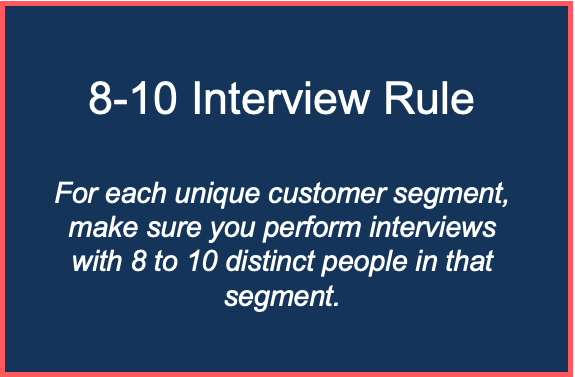Whenever we plan out a B2B interview-based market research project, one question always pops up: “How many customer interviews are enough?”
Of course, we also talk about the business objectives that drive the study and the learnings we want. But, planning for the number of participants tells us how much work we’ll need to put into the recruitment process. And, it offers insights into the types of people we need to ensure actionable data findings.
Why The Number Of Interview Participants Matters
Deciding on how many B2B customer interviews are enough all comes down to sample size. Or, more precisely, the number of people you need to feel confident that data reflects trends across a population and aren’t just a fluke.
After just a few interviews, you’ll likely hear some interesting ideas. But, you’ll be left wondering if those ideas truly represent consensus across a specific group. Or, if those ideas popped up due to random chance.
The more interviews you perform, the more you can determine how this nets out. If you hear it time and time again, you can mark it as a trend. However, if it arises just once or twice, you know it’s a niche theme.
The 8-10 Customer Interview Rule
Now that you know why interview sample size matters so much, let’s talk about how many B2B customer interviews are enough.
We have one rule of thumb: The 8-10 rule.
It’s really very simple. For each unique customer segment, make sure you perform interviews with 8 to 10 distinct people in that segment.
Why the 8-10 rule?
It comes back to the idea of having a large enough sample size to hear a trend arise multiple times. But, not so many interviews that you waste time and resources.

Interesting, pervasive themes usually arise by the fifth interview. By the eighth interview, we tend to hear it at least 4-5 times. By the tenth, we hear it a couple more times. This gives us strong confidence that this idea or theme is generally true for a given population.
At this point, you could hold more interviews. However, the cost likely outweighs the benefits. It’s unlikely you’ll hear any additional new ideas but you’ll have spent resources on those incremental interviews. Unless you need extreme certainty (in which case you should consider survey-based research), stop at ten interviews.
Why Recruit 8-10 Per Segment
Remember, the 8-10 rule applies to each unique segment you want to study. Let’s look at a few ways we’ve seen segments break out in B2B interviews:
- End Users vs. Managers
- Department A vs. Department B
- Job Title A vs. Job Title B
- Enterprise vs. SMB
Essentially, think about segments as groups that may have different responsibilities, perspectives, backgrounds, or goals within an organization. These differences drive them to assess situations differently. As a result, how they respond to any given question could be different too.
This is why we need 8-10 interviews per unique segment. We need enough interviews per segment to know if an idea is a pervasive theme, or not, within that segment. It then also lets us see if that theme exists across segments, or if each group takes a distinct view.
What Happens If You Do Not Follow The 8-10 Rule
Once people hear the 8-10 rule, it often begs another question, “What happens if we do fewer interviews?”
The truth is you can do fewer…but confidence levels will suffer. Fewer interviews means fewer opportunities for an idea or theme to appear. As a result, you may end up missing an interesting topic. Or, you may hear a topic but be left unsure of how pervasive a theme it is.
To be clear, that doesn’t mean don’t do six or seven interviews instead. Rather, it means go into the project knowing the downsides. 8-10 interviews strikes the perfect balance between gathering enough data and responsibly using resources. But, if you need some down and dirty information and only have time for five interviews, do it! Just don’t forget what you’re giving up as a result.






